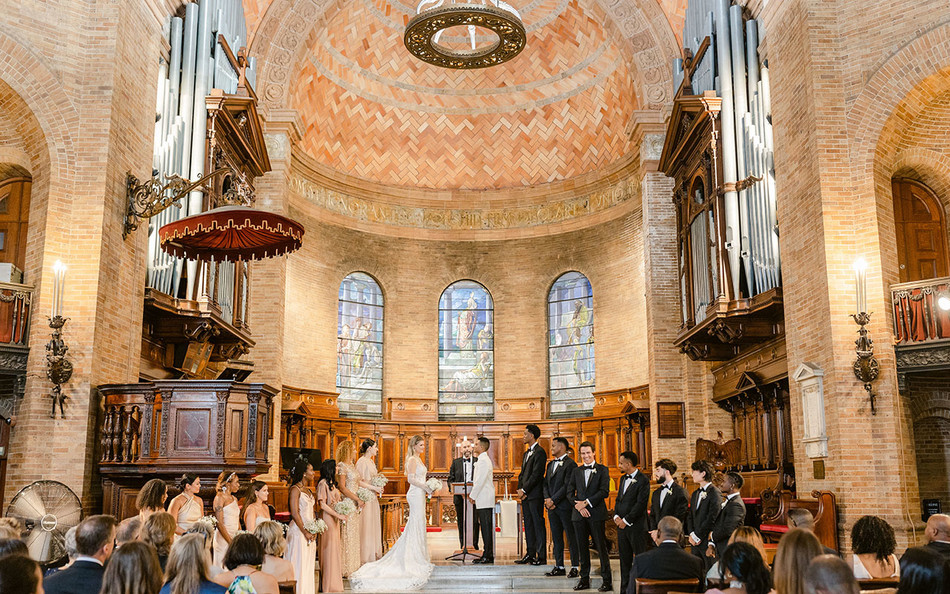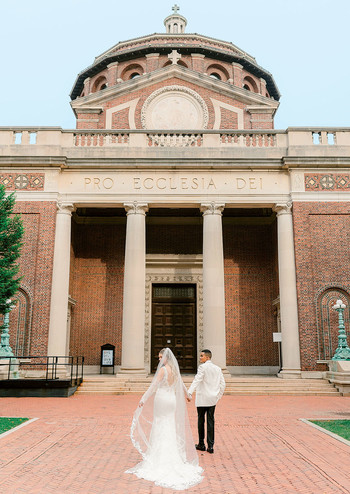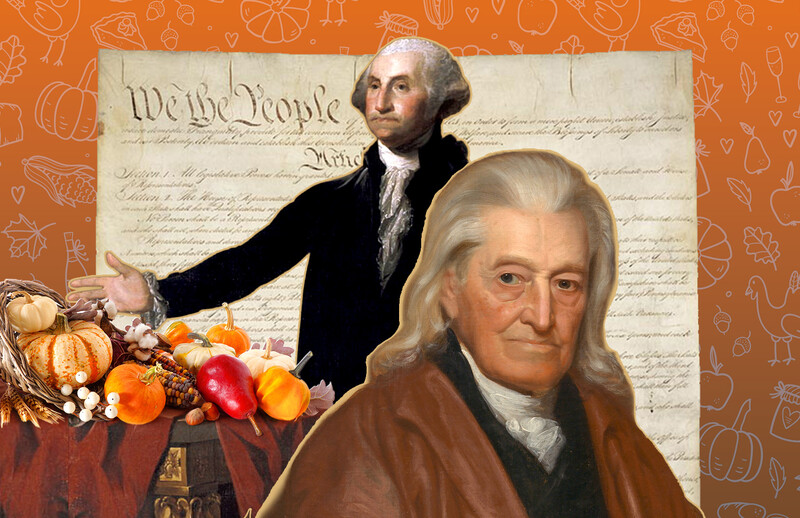Mollie Bayer-Yitayew ’19BC was in her first year of law school when she tried to organize her 150-person wedding to Michael Yitayew ’19CC without a wedding planner. Put simply: “It was a stressful time.” The couple had originally intended to hold their summer 2022 ceremony at the Cathedral of St. John the Divine, with a reception on campus at Faculty House. But after some logistical challenges with the cathedral, they turned to another New York City landmark: St. Paul’s Chapel at Columbia. “I had a lot of trust in Columbia, because we were students there; we weren’t just paying for a venue that we weren’t familiar with,” Bayer-Yitayew says. “They made the process so simple and straightforward.”
Dedicated in 1907 as an Anglican church, St. Paul’s was the first new building on the Morningside campus not built by McKim, Mead, and White. Architect I. N. Phelps Stokes designed an exterior that echoed the red brick and limestone of other campus buildings. The Byzantine interior, with its soaring ninety-one-foot-high vault decorated with pink Guastavino tiles and its 5,348-pipe Aeolian-Skinner organ, is considered a masterpiece. For Aaron Dai ’96GSAPP, who married Thomas Ashe at St. Paul’s in 2016, that interior, which he calls “both grand and intimate,” was an important factor. Another: “My graduation ceremony was held in St. Paul’s, so the chapel already held a special significance for me.”
St. Paul’s has hosted weddings since October 14, 1908, when Katrine Burdick, daughter of Columbia law professor F. M. Burdick, married Theodore Townsend in a short and simple ceremony in the newly built chapel. “Many floral pieces decorated the Chapel for this unusual occasion,” recounted the next day’s edition of the Spectator. “A large number of friends of the bride and groom was present, including some of the University professors and their wives.”
The cost of renting St Paul’s for a wedding has risen steadily over the years. In 1998 it cost $600 for two hours. Today a wedding at the chapel runs around $4,900, which includes a security officer, a custodian, and a basic audio setup with microphones and a hookup for your phone or laptop to play music over the sound system.
According to Emerald Currie ’13SOA, the director of Columbia University Event Management, approximately 80 percent of the weddings held in the chapel involve Columbia alumni or affiliates. The other 20 percent tend to be people who are attracted to the nondenominational nature of the chapel, which, “listening to brides, can be hard to find in New York City.” As the Reverend Dr. Ian Rottenberg, director of Columbia’s Earl Hall Center for Religious Life, says, “The chapel is for people of all faiths or people of no faith.” Rottenberg and his team can help couples find an officiant — or maybe several. “We recently had a request for a multi-faith, multi-officiant Hindu-Catholic wedding,” he says.
Currie recommends that couples book a year in advance to secure their preferred date. But last-minute planners won’t necessarily miss out: the chapel offers up to six wedding slots per weekend. “We had some alumni who were getting married in two weeks, and we actually had the space available,” Currie says.
There are a few site-specific rules. For one: “You can’t throw flower petals or rice inside because the inlaid-marble floor gets slippery,” Currie explains. Photographers are generally the only people allowed in to the balcony section, as a safety measure.
But as wedding venues go, St. Paul’s Chapel is relatively flexible. The only required vendor is a University-approved organist, such as Janet Yieh. “I usually talk with the couple and get a sense of what their ceremony will include and come ready with a list of wedding music,” she says.
The ceremony is where “the music and architecture really meet,” says Yieh. “There is such a warmth when you walk into the chapel. You see the organ pipes. You see the stained glass, the beautiful dome, and all the light streaming in.”
While Bayer-Yitayew says most of her wedding ceremony was “a blur,” she does remember the unadorned beauty of the chapel. “We didn’t add flower arrangements to the space because we felt it would take away from the architecture,” she says. “Even though I had been there as a student, it felt very different getting married there — almost regal.”
If you are interested in booking a wedding at St. Paul's Chapel, please contact Heather Lee, associate director of events and sales, at hl3660@columbia.edu.
This article appears in the Spring/Summer 2024 print edition of Columbia Magazine with the title "Going to the Chapel."




